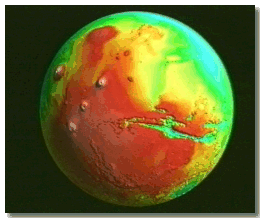4th rock from the Sun, and last of the terrestrial planets-Mars.
Though Mars is half the size of Earth, its cold, barren surface is about the area of all earth's dry land-and many think its majestic canyons and giant volcanoes should be humanity's next port of call...

In the 19th century, Mars-the Red Planet-was thought to be a place of huge canals and aliens...
In the 20th century, humans explored the planet close up with spacecraft, and found it lifeless.
...And in the 21st century, you may be one of the first explorers to land on Mars.
|
The water may be gone from the surface but maybe it's not "gone" completely, maybe it is near the surface and maybe there's processes that we don't quite understand that's causing a water turnover, maybe underground in ways that we still haven't figured out. And so the question of whether or not there's still a cycle, whether the water cycle is turning over in a completely different manner than it does on Earth... we don't know whether that's true or not, but it's certainly a very exciting time to be studying both Venus, Earth and Mars. |
|
Revolution |
Rotation |
Radius |
Distance From the Sun |
|
686.98 Earth days |
1.025957 Earth days |
3,397 km |
227,936,640 km |
|
Mass |
Density |
Surface Temperature |
Moons |
|
0.64191 x 1027 grams |
3.94 gm/cm3 |
27° to -133° C |
two: Phobos and Deimos |
|
Atmosphere |
Craters |
Volcanoes |
Water |
|
carbon dioxide, nitrogen and argon |
northern hemisphere has fewer than the southern hemisphere |
Olympus Mons is the largest volcano in the solar system |
The recent discovery of olivine, which weathers easily by water, in abundance on the surface may mean that earlier beliefs that water was/is present could be incorrect. |
|
You wake up early and you look and you see that salmon-colored sky with those clouds whisping across the surface. You'd see the sun rise bright and orange through that salmon-colored dust filled sky in the morning, and you'd see it rise up. And the sky would never be blue, it would remain that sort of pinkish-salmony color. You look out at the pictures of this rock-strewn field, and you could imagine walking on that surface from the rover's wheel tracks in the soil, you could imagine the footprints that you would leave. And you could imagine going over to Yogi and Barnacle Bill, and looking at them up close and looking around, you could kind of imagine what the surface would be like to walk on and what you would look at as you did that. And finally, if you could be on Mars without a spacesuit, which of course you can't, we now have the data from the weather station to actually feel what it would be like to be on Mars. Viking just didn't have enough sensors and they couldn't measure fast enough. But we know that if we were standing on the surface, our feet would be comfortably warm, band our head would need (laughs) a big hat and a scarf, it would be cold up there. 20 or so degrees of variance between the surface and where you're standing at, and then just standing there for a moment or two, we'd get 10-15 degree temperature swings just as we were standing there you'd be cold and hot in an instant. And finally just sort of feel these light breezes that were blowing on the surface. And so those really kind of make it into a place where you could actually imagine being on the surface. And that's kind of fun... (laughs) |
Take a VIRTUAL MARS tour of the Pathfinder landing site with Matt Golombek and others as your personal guides, using RealVideo clips.
|
WANT
TO LEARN MORE?
|
||
|
Missions: • Mars Global Surveyor • 2001 Mars Odyssey • Mars Pathfinder |
Recent Articles: • NASA Outlines Mars Exploration Program For Next Two Decades • MOC Images Suggest Recent Sources of Liquid Water on Mars |
Additional Links: • JPL's Solar System Exploration • The Nine Planets • Views of the Solar System • Windows to the Universe |
![]()

